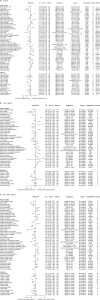Environmental Protective and Risk Factors for Gastric Cancer: An Umbrella Review and Reanalysis of Meta-Analyses
- PMID: 40200873
- PMCID: PMC11982512
- DOI: 10.5230/jgc.2025.25.e16
Environmental Protective and Risk Factors for Gastric Cancer: An Umbrella Review and Reanalysis of Meta-Analyses
Abstract
Purpose: Despite extensive research on gastric cancer (GC), efforts to consolidate the numerous associations between possible factors and GC risk remain lacking. This systematic review aimed to provide an overview of potential GC-associated pairs.
Materials and methods: We systematically searched PubMed, Embase, and Cochrane databases, from their inception to April 23, 2022, for eligible systematic reviews and meta-analyses to investigate the association between any possible factors and GC risk. After the inclusion of 75 systematic reviews and meta-analyses, 117 association pairs were examined. We reanalyzed the included meta-analyses and produced effect estimates using uniform analytical models. The certainty of the evidence for each association pair was evaluated using the Grading of Recommendations, Assessment, Development, and Evaluation (GRADE) criteria.
Results: Iatrogenic factors, including antibacterial drugs, were associated with an increased risk of GC. Epstein-Barr virus and Helicobacter pylori infections were also associated with an increased risk of GC, while human T-lymphotropic virus type 1 (HTLV-1) infections were associated with a reduced risk. Dietary habit was a major factor influencing moderate to high GRADE associations. Positive associations were observed for heavy alcohol consumption (relative risk [RR], 1.13; 95% confidence interval [CI], 1.06-1.12), refined grain consumption (RR, 1.36; 95% CI, 1.21-1.53), and habitual salt intake (RR, 1.41; 95% CI, 1.04-1.91).
Conclusions: The associations between GC risk and dietary and nutritional factors were considerably heterogeneous, whereas other factors, such as lifestyle and iatrogenic and environmental exposures, were consistent across regions. Therefore, dietary interventions for GC prevention should be tailored specific to regions.
Trial registration: PROSPERO Identifier: CRD42020209817.
Keywords: Gastric cancer; Meta-analysis; Risk factors; Stomach cancer; Umbrella review.
Copyright © 2025. Korean Gastric Cancer Association.
Conflict of interest statement
No potential conflict of interest relevant to this article was reported.
Figures



Similar articles
-
Association of Soy Foods With Gastric Cancer Considering Helicobacter pylori: A Multi-Center Case-Control Study.J Gastric Cancer. 2024 Oct;24(4):436-450. doi: 10.5230/jgc.2024.24.e39. J Gastric Cancer. 2024. PMID: 39375058 Free PMC article.
-
Effect of Helicobacter pylori eradication on the incidence of gastric cancer: a systematic review and meta-analysis.Gastric Cancer. 2019 May;22(3):435-445. doi: 10.1007/s10120-018-0876-0. Epub 2018 Sep 11. Gastric Cancer. 2019. PMID: 30206731
-
The relationship between the eradication of Helicobacter pylori and the occurrence of stomach cancer: an updated meta-analysis and systemic review.BMC Gastroenterol. 2025 Apr 21;25(1):278. doi: 10.1186/s12876-025-03886-z. BMC Gastroenterol. 2025. PMID: 40259215 Free PMC article.
-
Global estimate of gastric cancer in Helicobacter pylori-infected population: A systematic review and meta-analysis.J Cell Physiol. 2019 Feb;234(2):1208-1218. doi: 10.1002/jcp.27114. Epub 2018 Aug 21. J Cell Physiol. 2019. PMID: 30132888
-
Association Between Lifestyle Factors, Vitamin and Garlic Supplementation, and Gastric Cancer Outcomes: A Secondary Analysis of a Randomized Clinical Trial.JAMA Netw Open. 2020 Jun 1;3(6):e206628. doi: 10.1001/jamanetworkopen.2020.6628. JAMA Netw Open. 2020. PMID: 32589229 Free PMC article. Clinical Trial.
References
-
- Sung H, Ferlay J, Siegel RL, Laversanne M, Soerjomataram I, Jemal A, et al. Global Cancer Statistics 2020: GLOBOCAN estimates of incidence and mortality worldwide for 36 cancers in 185 countries. CA Cancer J Clin. 2021;71:209–249. - PubMed
-
- Puhan MA, Schünemann HJ, Murad MH, Li T, Brignardello-Petersen R, Singh JA, et al. A GRADE Working Group approach for rating the quality of treatment effect estimates from network meta-analysis. BMJ. 2014;349:g5630. - PubMed
Publication types
MeSH terms
LinkOut - more resources
Full Text Sources
Medical
Miscellaneous

